Zenith Trans-Oceanic
Model L600 Super Deluxe Trans-Oceanic
1954-1955
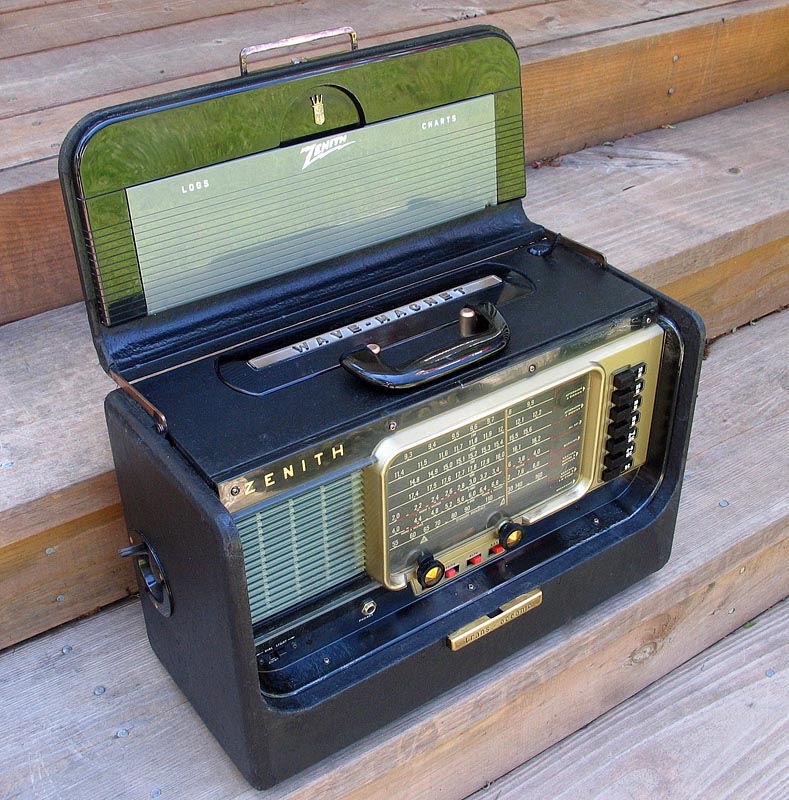
Introduced as the "Super Deluxe Trans-Oceanic" in early 1954, the L600 replaced the venerable H500, which had been proclaimed the "Super Trans-Oceanic" at its debut in 1951. The L600 was followed by the R600 and T600 in 1955, the Y600 in 1956-57, the A600 in 1958, and the B600 in 1959.
When the last B600 rolled off the assembly line in 1963, production of tube portable radios in the United States ceased. Zenith did continue production of the solid state Trans-Oceanics in the United States until 1979. The last two years of production, Zenith shipped parts for the R7000 solid state Trans-Oceanic to Taiwan for assembly. 1981 was the last year of production for the Zenith Trans-Oceanic.
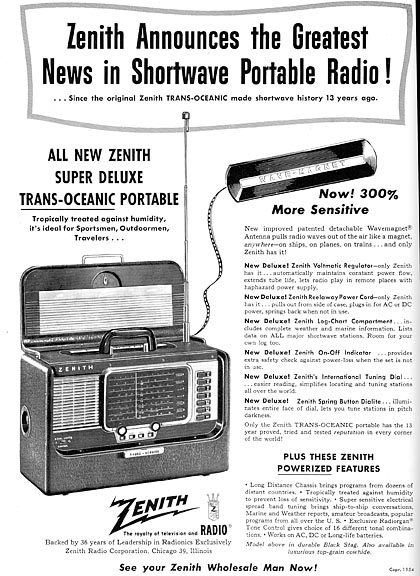 The L600 introduced a number of new features that made the radio much more user-friendly than previous models. Most noticeable was the slide rule dial, which replaced the airplane style dial used in all the previous models. The L600, as a result, was much easier to tune, and in the dark, the new dial light feature provided a back-light powered by a momentary switch to prevent battery drain. On the same note, the ON/OFF/VOLUME switch featured a small tab on the knob that served as a reminder to turn the radio off.
The L600 introduced a number of new features that made the radio much more user-friendly than previous models. Most noticeable was the slide rule dial, which replaced the airplane style dial used in all the previous models. The L600, as a result, was much easier to tune, and in the dark, the new dial light feature provided a back-light powered by a momentary switch to prevent battery drain. On the same note, the ON/OFF/VOLUME switch featured a small tab on the knob that served as a reminder to turn the radio off.
The L600 also introduced a another new feature, a spring-loaded take-up reel for the power cord. The power cord could be pulled out from the side and connected to the wall socket without opening the back of the radio, a major convenience. Unfortunately, if you wanted to use earphones, you still had to open the back.
This was corrected the following year with the T600 model, when the earphone jack was moved to the front panel, next to the dial light switch. Another nice touch that appeared sometime during the T600 run was a RCA line-in plug on the rear chassis apron for attaching a record player. Today, this jack can be used, with an adapter, to play an iPod, MP3 player, or CD player through all 600 series Trans-Oceanics except the L600 and R600.
Another nice feature was the smaller Wavemagnet that fit in a recess in the top of the cabinet. It could be popped out with a finger from underneath to mount on a window in a train or building to improve reception. It also eliminated the troublesome Wavemagnet connections that passed through the front lid hinges on the earlier models. A Waverod for shortwave reception was still provided. Adding both a nice styling touch as well as a convenience, the logbook and charts were mounted in a flip-down panel inside the front lid, an option that had been dropped on the 500 series Trans-Oceanics.
The L600 also made the 50A1 current regulator tube, first available in a few of the final H500 runs, a permanent feature of the electrical chassis. This permitted the L600 to function properly on AC power even when there were voltage fluctions, more common fifty years ago, without damage to the sensitive tube filaments by regulating the current flow to the tube filaments.
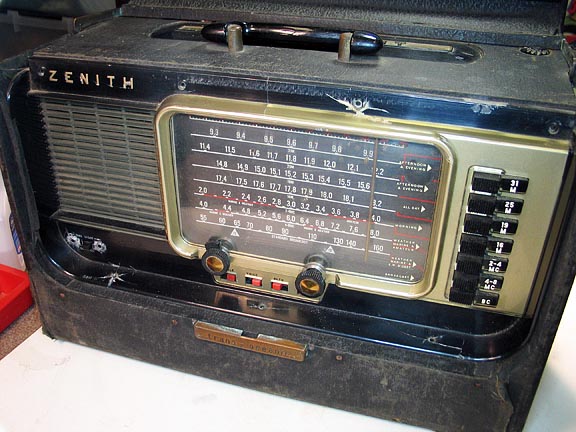 I found this L600 on a dusty shelf in the back room of an antique store. It was in very poor condition. The Black Stag covering was faded and threadbare and had come unglued in a number of places on the cabinet. The front panel had cracks around every screw hole, a condition found, unfortunatley on many 500 and 600 series Trans-Oceanics. This is caused by over-tightening of the screws when the front panel is removed and replaced after servicing the radio. As the front is reverse painted, there isn't any good repair for those ugly cracks. I found a front from a later model 600 radio, and replaced the damaged front (photo, top left). Because the later model 600's have the earphone jack on the front panel, I had to move the earphone jack from the rear chassis apron to the front. I have seen reports that some late run L600's may have had the earphone jack on the front panel.
I found this L600 on a dusty shelf in the back room of an antique store. It was in very poor condition. The Black Stag covering was faded and threadbare and had come unglued in a number of places on the cabinet. The front panel had cracks around every screw hole, a condition found, unfortunatley on many 500 and 600 series Trans-Oceanics. This is caused by over-tightening of the screws when the front panel is removed and replaced after servicing the radio. As the front is reverse painted, there isn't any good repair for those ugly cracks. I found a front from a later model 600 radio, and replaced the damaged front (photo, top left). Because the later model 600's have the earphone jack on the front panel, I had to move the earphone jack from the rear chassis apron to the front. I have seen reports that some late run L600's may have had the earphone jack on the front panel.
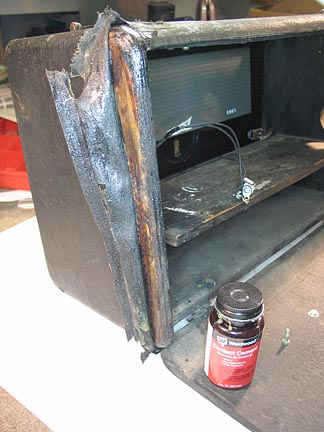 I did not choose to recover this radio, so I refurbished the cabinet by first re-gluing all the loose parts of the covering to the cabinet with Weldwood solvent based contact cement (photo, right). After the glue dried, I re-dyed the entire cabinet with Kiwi Scuff-Kote. And when that dried, I polished the cabinet with Kiwi black shoe polish. I removed the handle, log and chart enclosure, and Wavemagnet and cleaned them thoroughly, then polished them with Novus. I used white vinegar to remove the old lacquer on the front latch and handle bosses. After cleaning, I applied new lacquer.
I did not choose to recover this radio, so I refurbished the cabinet by first re-gluing all the loose parts of the covering to the cabinet with Weldwood solvent based contact cement (photo, right). After the glue dried, I re-dyed the entire cabinet with Kiwi Scuff-Kote. And when that dried, I polished the cabinet with Kiwi black shoe polish. I removed the handle, log and chart enclosure, and Wavemagnet and cleaned them thoroughly, then polished them with Novus. I used white vinegar to remove the old lacquer on the front latch and handle bosses. After cleaning, I applied new lacquer.
The radio did not play when I attached a battery. I then noticed that the tip of one of the tubes was broken off. I installed a new tube and the radio played. I sprayed contact cleaner into the band switches and worked them for several minutes, which noticeably improved reception on all the bands.
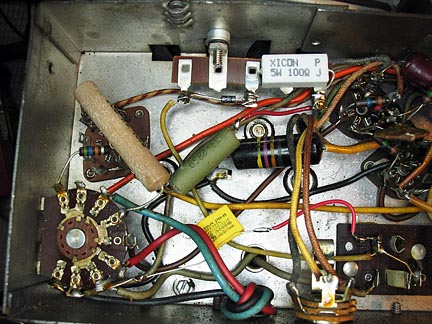 I replaced the four electrolytic capacitors contained in the multi-cap can that is mounted atop the chassis. For a brief discussion on the procedure I use to re-stuff the capacitor can on the Trans-Oceanic, see the B600 page. I did not replace any of the other capacitors, but I did install a safety capacitor across the AC line (yellow cap in photo at left).
I replaced the four electrolytic capacitors contained in the multi-cap can that is mounted atop the chassis. For a brief discussion on the procedure I use to re-stuff the capacitor can on the Trans-Oceanic, see the B600 page. I did not replace any of the other capacitors, but I did install a safety capacitor across the AC line (yellow cap in photo at left).
The radio played well on battery power, but the audio was distorted on AC power, an indication that tubes were not getting the correct voltage. I replaced the selenium rectifier with a 1N4007 silicon diode and a 5 watt 100 ohm resistor in series between the diode and the 130 ohm surge resistor (photo, left). The radio now plays well on AC power as well as battery power. As a final touch, I added a reproduction copy of the L600 Owners Manual and schematic.
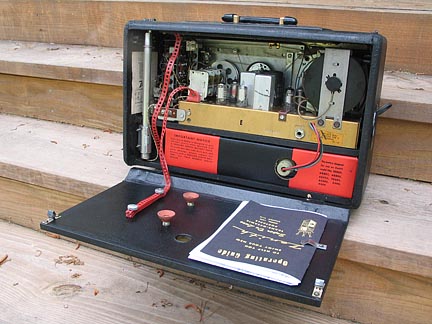



 The L600 introduced a number of new features that made the radio much more user-friendly than previous models. Most noticeable was the slide rule dial, which replaced the airplane style dial used in all the previous models. The L600, as a result, was much easier to tune, and in the dark, the new dial light feature provided a back-light powered by a momentary switch to prevent battery drain. On the same note, the ON/OFF/VOLUME switch featured a small tab on the knob that served as a reminder to turn the radio off.
The L600 introduced a number of new features that made the radio much more user-friendly than previous models. Most noticeable was the slide rule dial, which replaced the airplane style dial used in all the previous models. The L600, as a result, was much easier to tune, and in the dark, the new dial light feature provided a back-light powered by a momentary switch to prevent battery drain. On the same note, the ON/OFF/VOLUME switch featured a small tab on the knob that served as a reminder to turn the radio off.
 I found this L600 on a dusty shelf in the back room of an antique store. It was in very poor condition. The Black Stag covering was faded and threadbare and had come unglued in a number of places on the cabinet. The front panel had cracks around every screw hole, a condition found, unfortunatley on many 500 and 600 series Trans-Oceanics. This is caused by over-tightening of the screws when the front panel is removed and replaced after servicing the radio. As the front is reverse painted, there isn't any good repair for those ugly cracks. I found a front from a later model 600 radio, and replaced the damaged front (photo, top left). Because the later model 600's have the earphone jack on the front panel, I had to move the earphone jack from the rear chassis apron to the front. I have seen reports that some late run L600's may have had the earphone jack on the front panel.
I found this L600 on a dusty shelf in the back room of an antique store. It was in very poor condition. The Black Stag covering was faded and threadbare and had come unglued in a number of places on the cabinet. The front panel had cracks around every screw hole, a condition found, unfortunatley on many 500 and 600 series Trans-Oceanics. This is caused by over-tightening of the screws when the front panel is removed and replaced after servicing the radio. As the front is reverse painted, there isn't any good repair for those ugly cracks. I found a front from a later model 600 radio, and replaced the damaged front (photo, top left). Because the later model 600's have the earphone jack on the front panel, I had to move the earphone jack from the rear chassis apron to the front. I have seen reports that some late run L600's may have had the earphone jack on the front panel. I did not choose to recover this radio, so I refurbished the cabinet by first re-gluing all the loose parts of the covering to the cabinet with Weldwood solvent based contact cement (photo, right). After the glue dried, I re-dyed the entire cabinet with Kiwi Scuff-Kote. And when that dried, I polished the cabinet with Kiwi black shoe polish. I removed the handle, log and chart enclosure, and Wavemagnet and cleaned them thoroughly, then polished them with Novus. I used white vinegar to remove the old lacquer on the front latch and handle bosses. After cleaning, I applied new lacquer.
I did not choose to recover this radio, so I refurbished the cabinet by first re-gluing all the loose parts of the covering to the cabinet with Weldwood solvent based contact cement (photo, right). After the glue dried, I re-dyed the entire cabinet with Kiwi Scuff-Kote. And when that dried, I polished the cabinet with Kiwi black shoe polish. I removed the handle, log and chart enclosure, and Wavemagnet and cleaned them thoroughly, then polished them with Novus. I used white vinegar to remove the old lacquer on the front latch and handle bosses. After cleaning, I applied new lacquer. I replaced the four electrolytic capacitors contained in the multi-cap can that is mounted atop the chassis. For a brief discussion on the procedure I use to re-stuff the capacitor can on the Trans-Oceanic, see the
I replaced the four electrolytic capacitors contained in the multi-cap can that is mounted atop the chassis. For a brief discussion on the procedure I use to re-stuff the capacitor can on the Trans-Oceanic, see the 